Total population is higher by 24,165 persons
The total population of the Province of Tawi-Tawi as of August 1, 2015 was 390,715 persons based on the 2015 Census of Population (POPCEN). It comprised 10.3% of the ARMM total population. The 2015 population of the province is higher by 24,165 compared with 366,550 total populations in the 2010 Census of Population and Housing (CPH).

Tawi-Tawi posted a 6.6% total population growth rate
The Tawi-Tawi’s total population has a 6.6 percent total population growth rate (PGR) during the 2010-2015 periods. It was 7.12 percent lower than the PGR that was posted by the province during the 2000-2010 periods. Through the decades, the province growth rate shows positive trends. Based on the 2015 POPCEN, across ARMM, Tawi-Tawi is the second least numbered province.
The top most populous municipality of the province was Bongao (capital of Tawi-Tawi) comprising 25.7 percent of the total population of the province. It was followed by Panglima Sugala (Balimbing) and Languyan comprising 11.3 percent and 8.6 percent of the total population of the province respectively.

The province’s sex ratio stands at 102 males for every 100 females
Tawi-Tawi’s total population in 2015 has 50.4 percent males while 49.6 percent are females with a sex ratio of 102 males per 100 females. The 2010 CPH posted 101 males per 100 females. This means that through the years, males outnumbered the males. This trend can also be seen in majority of the age group of the population.
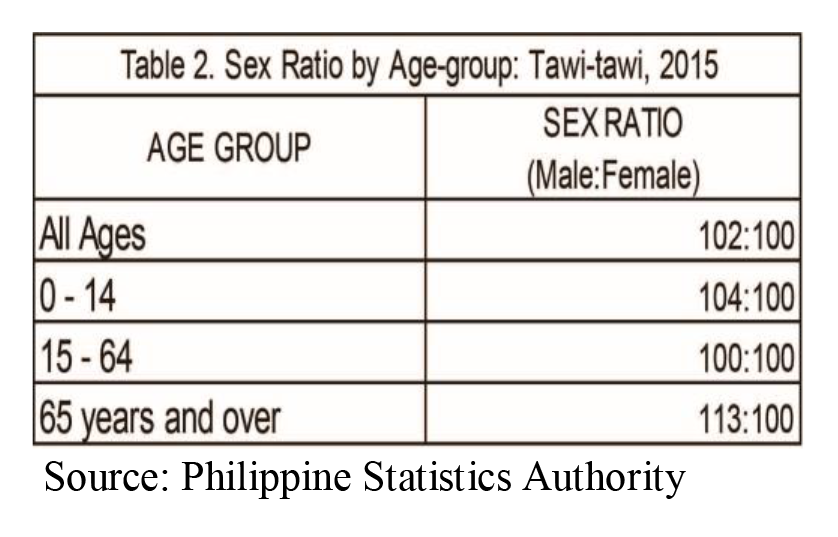
Median age slightly increased to 19.0 years
The result of the 2015 POPCEN also showed that the median age of Tawi-Tawi’s total population is 19.0 years old. This means that half of the total population is younger than or equal to 19.0 years old and another half of the total population is older than or equal to 19.0 years old. The median age of the province is higher as than the region. The median age of the province in 2010 CPH is 18.5 years old.
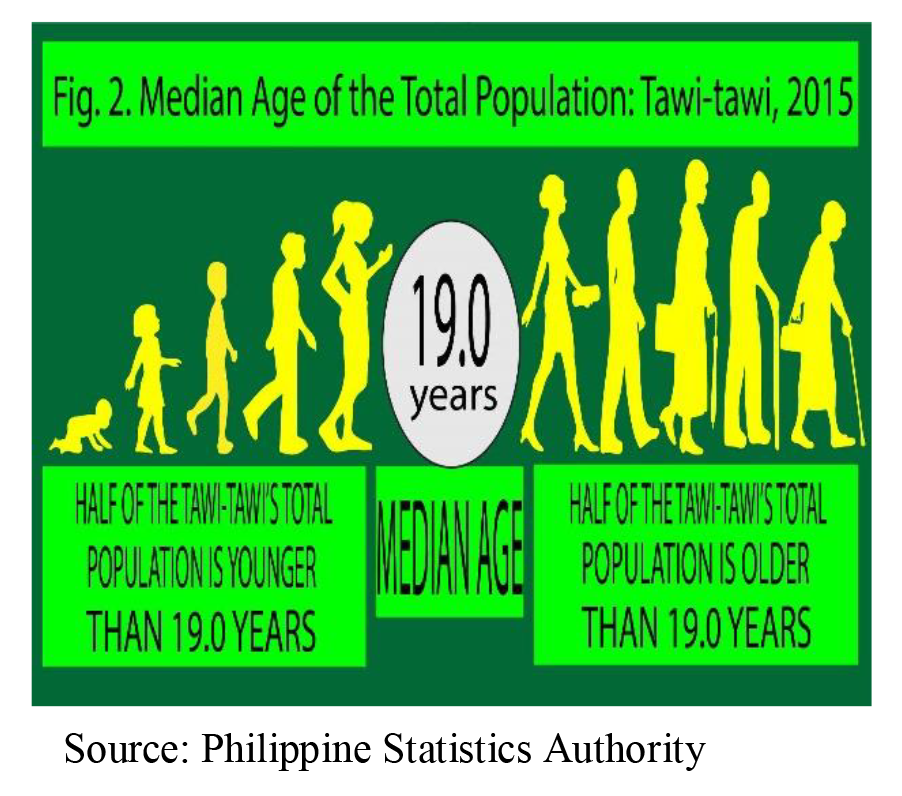
Children 5 to 9 years comprised the largest age groups of the population
Of the total population in the 2015, 40 percent are under 15 years of age or 156,287. Children aged 5 to 9 years comprised the largest part of the total population in the province which was 13.8 percent. Meanwhile, children of age under 5 years were accounted for 13.4 percent of the total population, and those 10 to 14 years with 12.9 percent. In 2010, children under 15 years old was accounted for 41.3 percent of the total population of the region, children of age 5 to 9 years with 14.6 percent and those children aged less than 5 years were accounted for 13.8 percent.
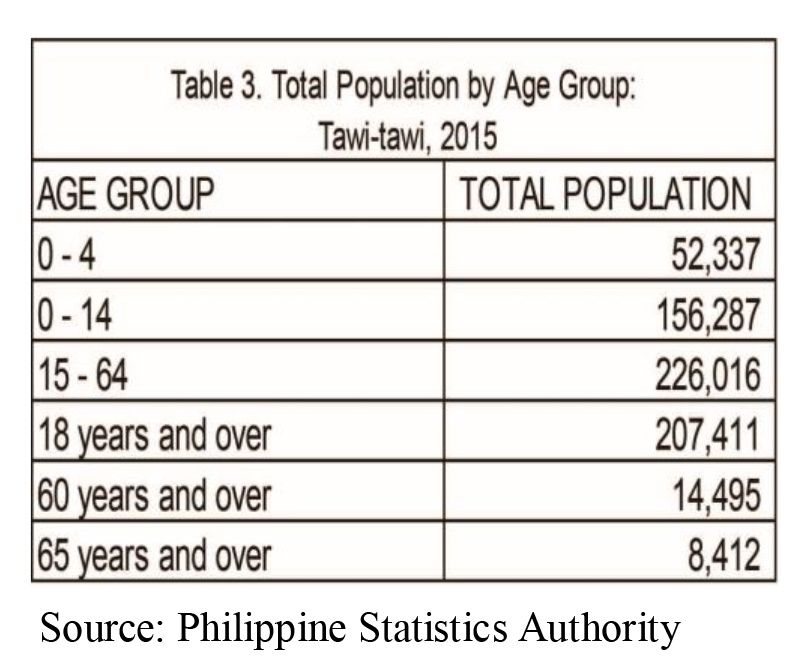
In terms of distribution by sex and age in the 2015 POPCEN, there are more males than females in the age groups 0 to 19 years old and 40 years and over, with males comprising 35.8 percent of the total population. In the contrary, there are more females than males in the age groups 20 to 39 years old with females comprising 15.4 percent of the total population. On the other hand, the proportions of males and females in the age groups 35 to 39 years old, 65 to 69 years old, 70 to 74 years old, 75 to 79 years old, and 80 years and over are almost the same. It also means that they almost had equal population.

Dependency ratio decreases to 73 dependents per 100 persons in the working-age group
In the 2015 POPCEN, the young dependents (0 to 14 years old) comprised 69.1 percent (or 156,287 persons) of the total population, while the old dependents (65 years old and over) comprised 3.7 percent (or 8,412 persons) of the total population. The working-age population (15 to 64 years old) accounted for the remaining 57.8 percent (or 226,016 persons).
The overall dependency ratio of Tawi-Tawi is 72.9, which indicates that for every 100 working-age population, there are about 73 or more dependents (69 young dependents and more or less 4 old dependents). This is lower than the dependency ratio in 2010 recorded at 75 dependents per 100 working-age population (72 young dependents and 3 old dependents).
More than half of the total population can vote
In Tawi-Tawi, the voting-age population or persons 18 years old and over accounted for 53.1 percent of the total population (207,411 persons) based on the 2015 POPCEN. Persons that cannot vote or persons 17 years old and below accounted for 46.9 percent (183,304 persons). Of the voting-age population, 50.1 percent are males and 49.9 percent are female. The province’s voting age population comprises 10.8 percent of the region’s voting age population.
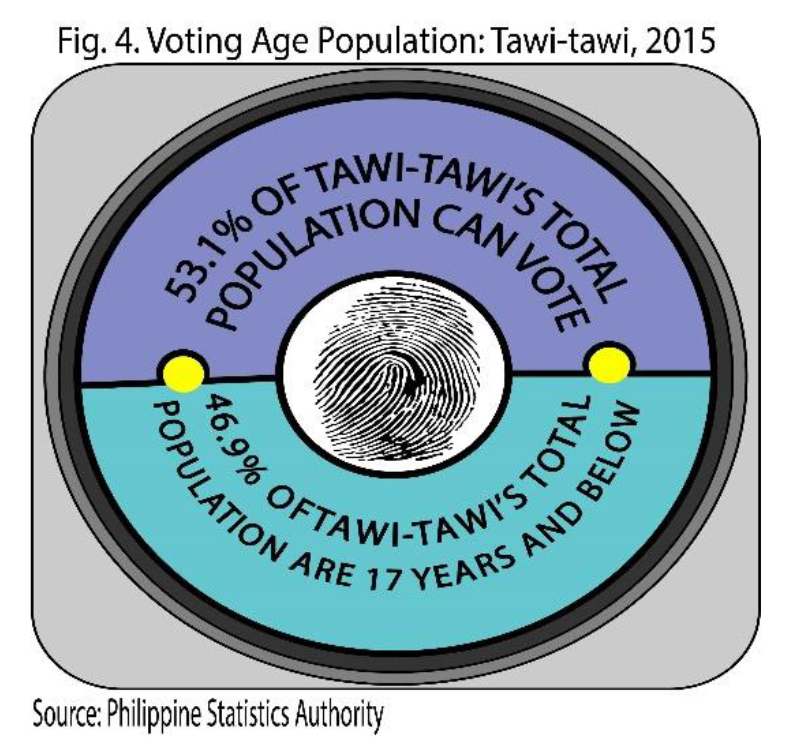
All municipalities of Tawi-Tawi has voting-age population comprising more than 40 percent of their respective total population, with the Municipality of Simunul having the highest proportion of voting-age over total population at 59.1 percent, followed by the Turtle Islands at 57.5 percent, Sibutu at 56.2 percent, and the lowest is in the Municipality of Sitangkai estimated only at 52.8 percent.
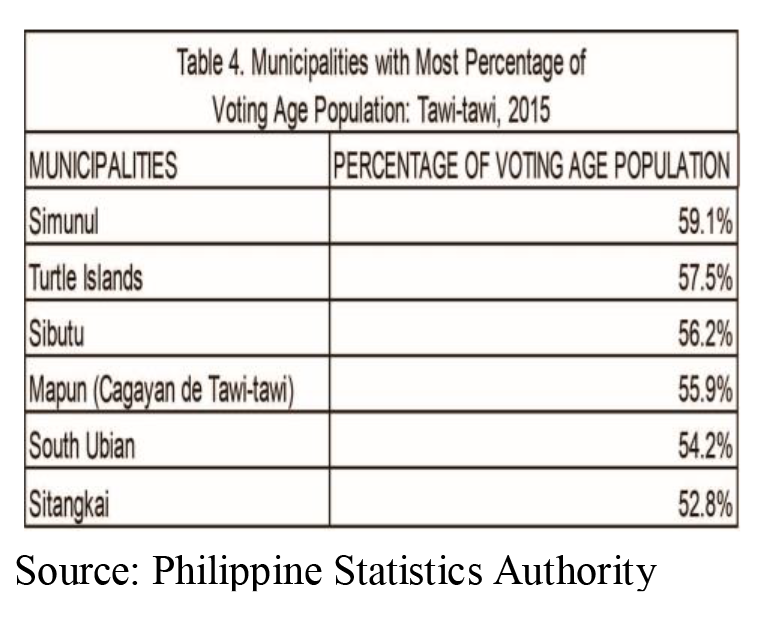
Senior citizens constitute 3.7 percent of the total population
Senior citizens are those people who are aged 60 years and over. In Tawi-Tawi, there were 14,495 senior citizens making up 3.7 percent of the 390,715 total populations in the 2015 POPCEN, which is slightly higher than the 3.0 percent recorded in 2010. Among the senior citizens, the males estimated at 54.4 percent outnumbered the females at 45.6 percent. By municipalities, the Municipality of Mapun (Cagayan de Tawi-Tawi) has the highest proportion of senior citizens estimated at 5.2 percent, followed by the Municipality of Simunul at 4.6. The Municipality of Languyan has the lowest proportion of senior citizens estimated only at 2.7 percent of its total population.
Almost half of the total populations were in the married persons group
Across provinces in ARMM, Tawi-Tawi ranked fourth for the highest proportion of married persons which was estimated at 48.0 percent of its total population. Among the married persons group, male population comprises 50.1 percent of the population. Meanwhile, the proportion of single persons is 48.0 percent, in common-law or live-in marital arrangement is 0.2 percent, widowed persons is 3.0 percent and in divorced or separated persons is 0.8 percent.

School Attendance Rate in the province had increase over the years
Persons aged 5 to 24 years old are considered in determining the school attendance rate. Based on the 2015 POPCEN results there are 180,773 persons who are 5 to 24 years old in Tawi-Tawi and 65.8 percent that is 118,968 of them are attending school in school year 2015-2016 that is higher than the school attendance rate in 2010 CPH which is estimated at 56.8 percent.
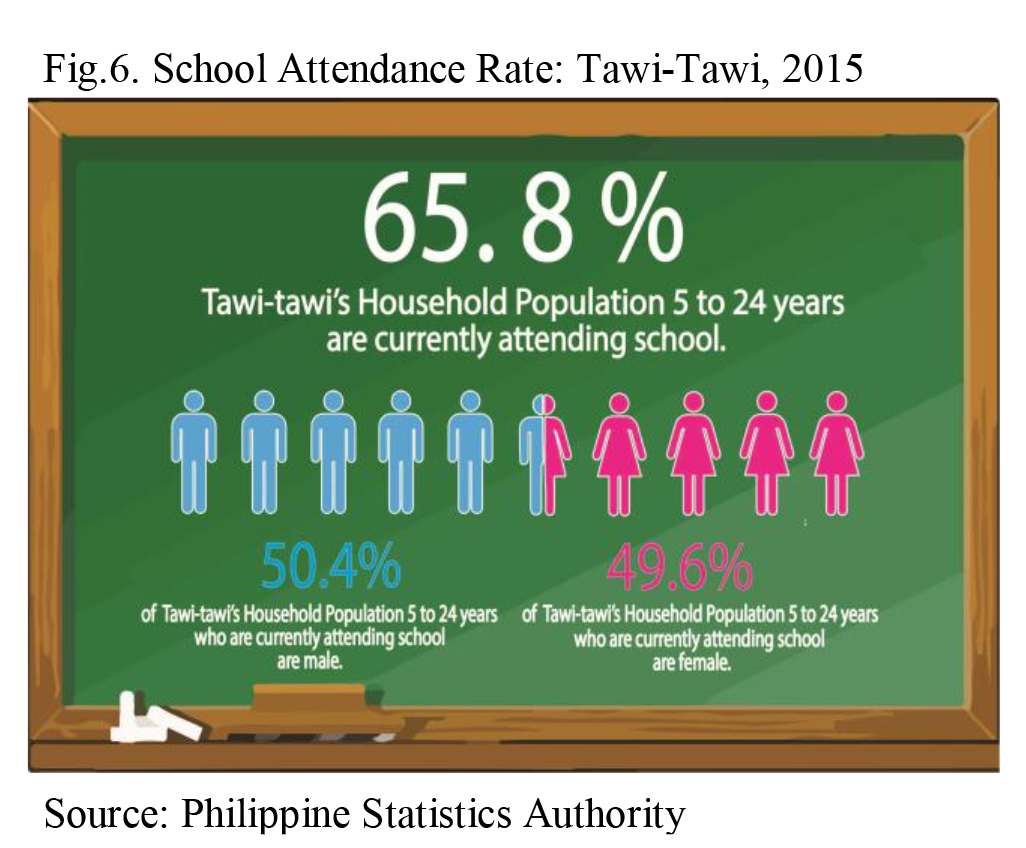
Out of the 2015 school attendance rate, males are higher than the males with 50.4 percent and 49.6 percent, respectively.
Tawi-Tawi’s simple literacy rate was recorded at 89.3 percent in 2015
The simple literacy rate of the Province of Tawi-Tawi based on 2015 POPCEN is 87.2 percent among the 283,693 household population aged 10 years and over. It is higher than its simple literacy rate in 2010 CPH which is estimated only at 74.6 percent. A person can be considered as literate if he is able to read and write a simple message in any language or dialect. Out of the 87.2 percent literacy rate, 50.2 percent are males and 49.8 percent are females.
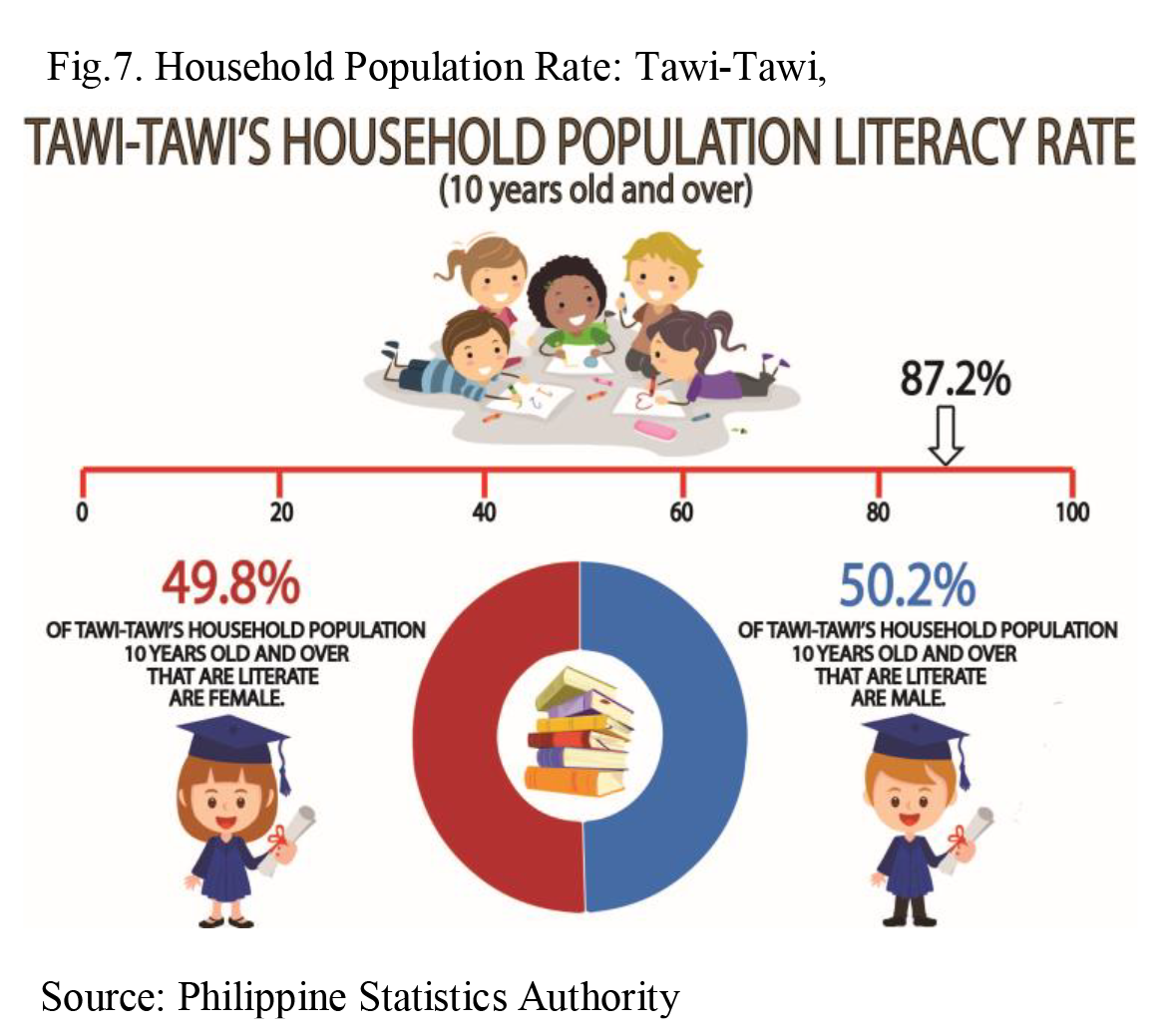
Males outnumbered females in academic degree and school attendance rate
Of the total population 5 years old and over across Tawi-Tawi, 41.2 percent of the total population had reached elementary grade. 80.4 percent here are undergraduates while 19.6 percent are graduates. Also, 24.4 percent of the total population already reached high school level only. Among those with baccalaureate degree, there were more males (59.6 percent) than females (40.4 percent).

Tawi-Tawi had increase its number of households in 2015
The number of households in the province had increased by 5.7% from 63,887 in 2010 to 67,529 in 2015. The household population of Tawi-Tawi reached 389,714 persons in 2015. This is 24,278 higher than the 365,436 household population reported in 2010. The province registered an average household size of 6.0 persons, which is 0.1 higher than the average household size registered in 2010 which is 5.8.
The following municipalities have an average household size higher than its provincial level namely: Panglima Sugala, Mapun (Cagayan de Tawi-Tawi), Tandubas, Turtle Islands, Sapa-sapa and Sibutu. On the other hand there are only five municipalities which recorded a lower average household size than its provincial level like Bongao, Simunul, Sitangkai, South Ubian and Languyan. Average household size tells us how much average number of persons is residing within a household in a particular area.

Technical Notes
Total population is the sum of the household population and institutional population. It also includes Filipinos in Philippine embassies, consulates, and missions abroad.
Population growth rate is the rate at which the population is increasing (or decreasing) in a given period due to natural increase and net migration, expressed as a percentage of the base population.
Dependency ratio is the ratio of persons in the dependent ages (under 15 years old and over 64 years old) to persons in the economically active or working ages (15 to 64 years old) in the population.
Voting age population (VAP) refers to the set of individuals that have reached the minimum voting age for a particular geographical or political unit.
Marital status is the personal status of each individual with reference to the marriage laws or customs of the country.
School attendance rate is the proportion of persons 5 to 24 years old who were attending school during the School Year June 2015 to March 2016 to school-age population (5 to 24 years old).
Simple literacy rate is the proportion of persons aged 10 years and over who are able to read and write a simple message in any language or dialect.
Highest grade / year completed are the highest grade or year completed in school, college or university.
MASIL H. MOHAMMADSHA, MPA
Chief Statistical Specialist
